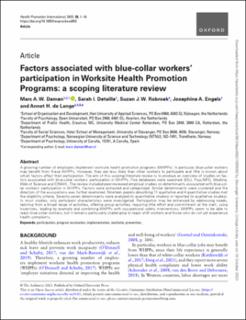| dc.contributor.author | Damen, Marc A. W | |
| dc.contributor.author | Detaille, Sarah I | |
| dc.contributor.author | Robroek, Suzan J. W | |
| dc.contributor.author | Engels, Josephine A | |
| dc.contributor.author | De Lange, Antoinette Harmke | |
| dc.date.accessioned | 2023-11-22T11:44:25Z | |
| dc.date.available | 2023-11-22T11:44:25Z | |
| dc.date.created | 2023-07-25T11:34:30Z | |
| dc.date.issued | 2023 | |
| dc.identifier.citation | Damen, M. A., Detaille, S. I., Robroek, S. J., Engels, J. A., & de Lange, A. H. (2023). Factors associated with blue-collar workers’ participation in Worksite Health Promotion Programs: a scoping literature review. Health Promotion International, 38(3), daad052. | en_US |
| dc.identifier.issn | 0957-4824 | |
| dc.identifier.uri | https://hdl.handle.net/11250/3104099 | |
| dc.description.abstract | A growing number of employers implement worksite health promotion programs (WHPPs). In particular, blue-collar workers may benefit from these WHPPs. However, they are less likely than other workers to participate and little is known about which factors affect their participation. The aim of this scoping literature review is to produce an overview of studies on factors associated with blue-collar workers’ participation in WHPPs. Five databases were searched: BSU, PsycINFO, Medline, Web of Science and CINAHL. The review included peer-reviewed empirical studies on determinants associated with blue-collar workers’ participation in WHPPs. Factors were extracted and categorized. Similar determinants were clustered and the direction of the associations was further examined. Nineteen papers describing 11 qualitative and 4 quantitative studies met the eligibility criteria. Seventy-seven determinants were analyzed (in quantitative studies) or reported (in qualitative studies). In most studies, only participant characteristics were investigated. Participation may be enhanced by addressing needs, tailoring from a broad range of activities, offering group activities, requiring little effort and commitment at the start, using incentives, leading by example and combining WHPPs with occupational safety interventions. WHPPs seem to be able to reach blue-collar workers, but it remains particularly challenging to reach shift workers and those who do not yet experience health complaints. | en_US |
| dc.language.iso | eng | en_US |
| dc.publisher | Oxford University Press | en_US |
| dc.rights | Navngivelse-Ikkekommersiell 4.0 Internasjonal | * |
| dc.rights.uri | http://creativecommons.org/licenses/by-nc/4.0/deed.no | * |
| dc.title | Factors associated with blue-collar workers' participation in Worksite Health Promotion Programs: A scoping literature review | en_US |
| dc.type | Peer reviewed | en_US |
| dc.type | Journal article | en_US |
| dc.description.version | publishedVersion | en_US |
| dc.rights.holder | © The Authors | en_US |
| dc.subject.nsi | VDP::Samfunnsvitenskap: 200::Økonomi: 210 | en_US |
| dc.subject.nsi | VDP::Medisinske Fag: 700::Helsefag: 800::Samfunnsmedisin, sosialmedisin: 801 | en_US |
| dc.source.pagenumber | 16 | en_US |
| dc.source.volume | 38 | en_US |
| dc.source.journal | Health Promotion International | en_US |
| dc.source.issue | 3 | en_US |
| dc.identifier.doi | 10.1093/heapro/daad052 | |
| dc.identifier.cristin | 2163430 | |
| dc.source.articlenumber | daad052 | en_US |
| cristin.ispublished | true | |
| cristin.fulltext | original | |
| cristin.qualitycode | 1 | |

